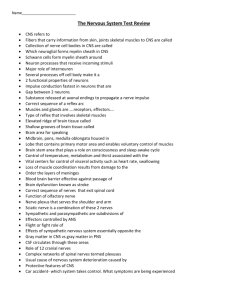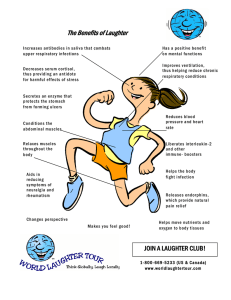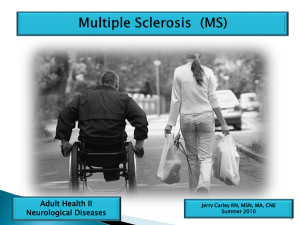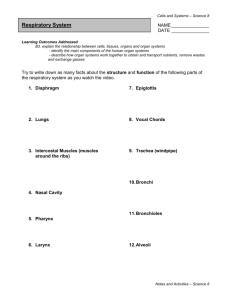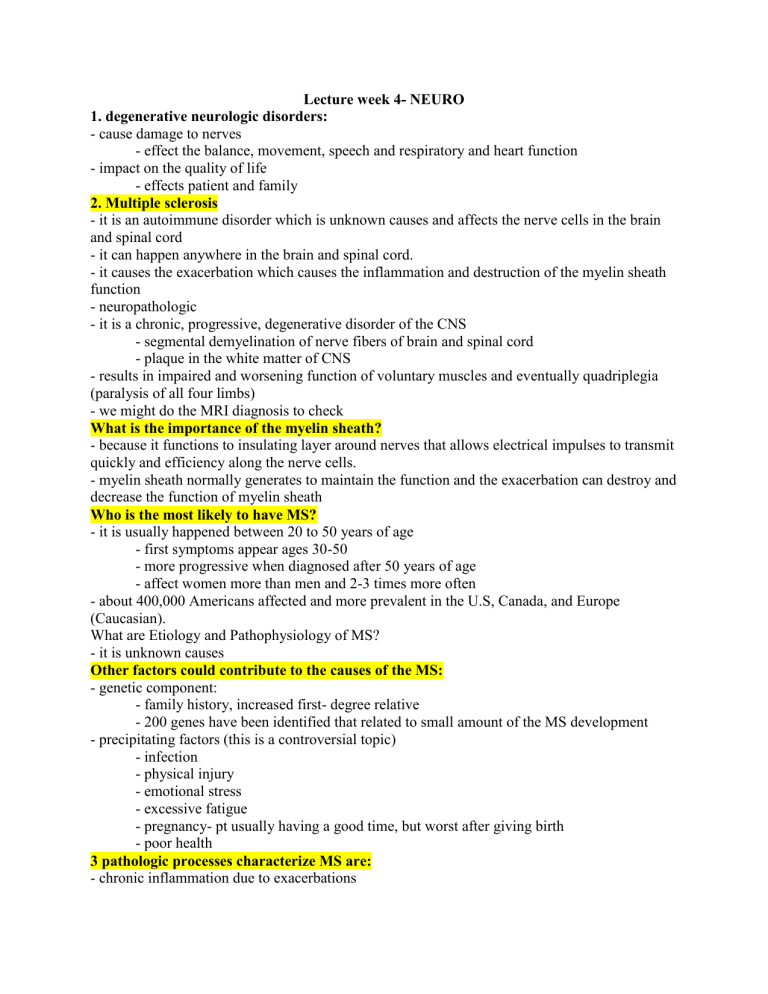
Lecture week 4- NEURO 1. degenerative neurologic disorders: - cause damage to nerves - effect the balance, movement, speech and respiratory and heart function - impact on the quality of life - effects patient and family 2. Multiple sclerosis - it is an autoimmune disorder which is unknown causes and affects the nerve cells in the brain and spinal cord - it can happen anywhere in the brain and spinal cord. - it causes the exacerbation which causes the inflammation and destruction of the myelin sheath function - neuropathologic - it is a chronic, progressive, degenerative disorder of the CNS - segmental demyelination of nerve fibers of brain and spinal cord - plaque in the white matter of CNS - results in impaired and worsening function of voluntary muscles and eventually quadriplegia (paralysis of all four limbs) - we might do the MRI diagnosis to check What is the importance of the myelin sheath? - because it functions to insulating layer around nerves that allows electrical impulses to transmit quickly and efficiency along the nerve cells. - myelin sheath normally generates to maintain the function and the exacerbation can destroy and decrease the function of myelin sheath Who is the most likely to have MS? - it is usually happened between 20 to 50 years of age - first symptoms appear ages 30-50 - more progressive when diagnosed after 50 years of age - affect women more than men and 2-3 times more often - about 400,000 Americans affected and more prevalent in the U.S, Canada, and Europe (Caucasian). What are Etiology and Pathophysiology of MS? - it is unknown causes Other factors could contribute to the causes of the MS: - genetic component: - family history, increased first- degree relative - 200 genes have been identified that related to small amount of the MS development - precipitating factors (this is a controversial topic) - infection - physical injury - emotional stress - excessive fatigue - pregnancy- pt usually having a good time, but worst after giving birth - poor health 3 pathologic processes characterize MS are: - chronic inflammation due to exacerbations - demyelination (decreased in the function) - gliosis in the CNS (gliosis = shine)- a scarring that occurs in the CNS MS developing process: - autoimmune process - triggers activated T cells that migrate to CNS - activates inflammatory response - causes demyelination of axons. In the late term: It initially, attacks cause damage to myelin sheaths of neurons in brain and spinal cord - nerve fiber is not affected - myelin sheath is able to regenerate Patient also may complain of noticeable impairment of function On going term: Ongoing inflammation, myelin sheath loses ability to regenerate - nerve impulse transmission is disrupted without myelin- permanent loss of nerve function - glial scar tissue causes hard, rigid plaque Use MRI to check Clinical manifestations Onset: - gradual: vague, not enough details to seek for medical attention like fatigue, and it diagnosed long after onset of the 1st symptoms - Rapid: onset sudden, rapid progressive deterioration (a process of becoming progressively worse) Chronic: - progressive deterioration - overall trend is progressive deterioration in neurologic function Remissions and exacerbations in others - symptoms are vary depends on each areas of CNS involved - others have occasional and mild symptoms for several years - some have severe, long-lasting symptoms early in disease. Initial symptoms may include - blurred or double vision (1st symptoms) - red-green color distortion - blindness on one eye COMMON CLINICAL MANIFESTATION OF MS Motor problems: -muscles are chronically affected - weakness or paralysis of Limbs, Trunk, Head - Spasticity of muscles (muscles spasms)- really painful. - tremors - scanning speech (spoken words are broken up into separate syllables, varying force) Sensory manifestations - numbness and tingling (paresthesia) - pain on low thoracic, abdomen - decreased hearing function - vertigo and tinnitus - Lhermitte’s sign (electric shock like passes down the back of neck into the spine - chronic neuropathic pain. Cerebellar Manifestations - Nystagmus (rapid involuntary movements of eyes) - Ataxia (loss of full control of bodily movements) - Dysarthria (difficult or unclear articulation of speech) - Dysphagia (difficult in swallowing) - severe fatigue- trigged by the heat, humidity, medications - bowel such as constipation - bladder such as - spastic bladder: urgency/frequency - flaccid (soft, drooping) bladder: urinary retention Emotional Manifestations - anger- due to the effect of the brain - depression - Euphoria Cognitive manifestations: approx. 50% pt have this problem - difficulty with short-term memory attention - attention - information processing - planning - visual perception - word finding Diagnostic studies of MS - do definitive diagnostic test - usually based on - history - clinical manifestation: presence of plaques, inflammation, atrophy (degeneration cells) Tissue breakdown/destruction - MRI of brain and spinal cord - cerebral spinal fluid (CSF) analysis - increased immunoglobulin G determine disease severity How to know pt have MS based on diagnosed test? - have at least 2 inflammatory demyelinating lesions in 2 different locations with CNS - damage or an attack occurring at different times (usually > 1 month apart) - all other possible diagnoses must have been ruled out Drug Therapy for MS: No cure for MS - treat disease process - provide symptomatic relief - therapy is tailored specifically to disease pattern and manifestations experienced by each patient. Goal: early intervention is most effective. Using the immunosuppressants for the drug therapy: - corticosteroids (methylprednisolone, prednisone) helps in treating acute exacerbations Reduce the edema, acute inflammation at the site of demyelination Common S/E: increased blood glucose, immunosuppression, weight gain thinning of the skin, bruising easily, insomnia, mood changes. INTERPROFESSIONAL CARE Immunomodulators - the drugs are used initially to modify the disease progression and prevent relapses - interferon B-1a (SQ Rebif and Plegridy; IM Avonex - interferon B-1b (SQ Betaseron and Extavia Common SE of these drugs: headache, tight muscles, vaginal bleeding between menstrual periods, teratogenic (agent caused malformation of an embryo), liver damage. SUPPORTIVE THERAPY - muscle relaxants: Valium (diazepam) - CNS stimulants: Methylphenidate (Ritalin) fatigue - Anticholinergics: Oxybutynin (Dantrium) for bladder symptoms - tricyclic Antidepressants: chronic pain - selective potassium channel blocker: Dalfampridine (Ampyra)- improve nerve conduction - antiseizure drugs: Phenytoin to protect neural tissue Exercise - relieve spasticity - improve coordination - train patient to substitute unaffected muscles for impaired muscles Water therapy NURSING PLANNING - maximize neuromuscular function - maintain independence an activity of daily living for as long as possible - manage fatigue - Optimize psychological well-being - adjust to the illness - decrease factors that precipitate exacerbations TEACHING PT: - use new catheter every time - high fiber diet to relieve constipation - emotional adjustments - lifestyle changes GUILLAIN-BARRE SYNDROME (GBS) - an autoimmune disorder- Acute disorder - often occurs days or weeks after viral or bacterial infection - acute destruction of the myelin sheath of peripheral nerves - edema and inflammation of the affective nerves such as muscle weakness and paralysis Etiology - immune response causes edema, inflammation of nerves - damage to myelin sheath of peripheral nerves - nerves impulses are stopped or slowed - patient develops paralysis- proximal to distal pattern Clinical Manifestations - acute, ascending, rapidly progressive, symmetric weakness of the limbs. Affect from the toes to the nose. - initially bilateral lower extremity muscles are affected then progresses upward through arms and thorax - start with muscle flaccidity- to muscle atrophy - paresthesia - diplopia (double vision), facial weakness, dysarthria (difficult or unclear articulation of speech), dysphagia - signs of respiratory compromise Pt might have residual numbness, can’t feel and it can travel from feet to nose. Diagnostic Studies - use the history and clinical signs - progressive weakness of more than one limb - absent or diminished reflexes - obtain CSF to exclude other causes - EMG- electromyography and nerve conduction studies RISK FACTORS - possibly autoimmune - more common in 20-to-50-year old’s - association with swine flu immunizations - frequently preceded by mild respiratory or intestinal infection NURSING ASSESSMENT Neuro: check for motor and sensory function, cranial nerves, LOC, mental status Cardiac: Rate, rhythm, check for irregular heart rate, work of breathing Respiratory: work of breathing, pt are able to swallow GI: risk for aspiration paralytic ileus, listen to bowel sounds INTERVENTIONS Directed toward the treatment of symptoms Monitor respiratory status closely Prepare to initiate respiratory support Monitor cardiac status Assess for complications of immobility GBS Management Supportive care: 30% of GBS progress to respiratory failure Immunomodulating treatments: - plasmapheresis: remove antibodies - High-dose IV Ig interferes with antigen presentation Psychosocial support: - recovery usually within 28 days - 80% make a near total recovery - 65% have minor residual symptoms MYASTHENIA GRAVIS (Bệnh nhược cơ) An autoimmune disease affecting neuromuscular junction Occurs more often in women It causes fluctuating muscles weakness that increases with muscle use It is rare and approximately 60,000 people in the US have MG Etiology - it is an autoimmune response Caused the antibodies form and these antibodies interfere with nerve conduction that transmission and affect the system. Antibodies form and attack acetylcholine (ACH) receptors Decreased the number of ACH receptor at neuromuscular junction - prevents Ach molecules from attaching - prevents stimulation of muscle contraction CLINICAL MANIFESTATION - progress, fluctuating weakness of skeletal muscles - bilateral ptosis (drooping of upper eyelid due to paralysis or disease) - diplopia (double vision) - difficulty with speech, chewing and swallowing - facial immobility s/s comes and goes fast Neuro: no neurological changes, no sensory loss because it does not effect on the brain and no change in mental status. Respiratory: muscles of trunk maybe affected in crisis Musculoskeletal: muscles of neck, shoulder and hips can be affected Myasthenic crisis- life threatening - acute exacerbation of muscle weakness- trigged by resp infection, stress, surgery, emotional upset - major complication- weakness in muscles that affect swallowing and breathing, and it may require intubation and ventilation - risk for Aspiration, respiratory insufficiency, and respiratory tract infections Diagnostic Studies - history and physical - electromyography (EMG)- decreased response to repeated stimulation Labs: 90% of pts have anti-AChR antibodies - pt will receives IV injection of tensilon - tensilon helps reverses symptoms of MG Helps to inhibit the enzyme that breaking down acetylcholine and prevent acetylcholine from breaking down. Allowing them to bind to receptor as much as possible. It works quickly to reduce the symptoms. IV route INTERPROFESSIONAL CARE: Anticholinesterase agents: prolongs the action of Ach which facilitates transmission of impulses at the neuromuscular junction. - Neostigmine (Prostigmine) and Pyridostigmine (Mestinon) Corticosteroid: help to suppress the immune response such as Prednisone (Detasone) Immunosuppressants: helps to suppress the immune response - azathioprine (Imuran) is given if steroids are ineffective IV immunoglobulins (IVIg)- utilized in acute crisis, short term improvement Plasmapheresis: directly removes circulating AChR antibodies which helps decrease symptoms Nursing Management - pt admitted due to respiratory infection of crisis of: Airway Assess for muscle weakness Assess swallowing Keep oxygen, endotracheal intubation, and suctioning equipment, and a bag valve available Small and frequent high calories meals Have pt sit up right when eating and thick liquids diet to prevent aspiration BELL’S PALSY An acute, and acute peripheral facial paresis of unknown cause It is a most common nerves disorder - inflammation of Cranial Nerve VII, and unilateral - benign and occurs in the absence of any other disease Peak incidence between 15-60 years of age Spontaneous recovery between 3 weeks and 9 months Susceptible groups - women in the 3rd trimester of pregnancy - early postpartum - older adults - diabetes and Hypothyroidism Etiology Exact cause if unknown
